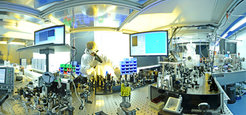A Stopwatch for Electron Flashes
Physicists at LMU Munich and the Max-Planck-Institute of Quantum Optics measure the duration of energetic electron pulses using laser fields.
A stopwatch made of light can determine the duration of extremely brief electron flashes. Teams based in the Laboratory for Attosecond Physics (LAP) at LMU and at the Max Planck Institute of Quantum Optics have, for the first time, succeeded in measuring the lengths of ultrashort bursts of highly energetic electrons using the electric fields of laser light. Such electron pulses, which behave like ultrashort matter waves, provide time-resolved recordings of processes taking place in molecules and atoms, enabling elementary particles to be "filmed" in four dimensions. The new stopwatch for electrons now permits even more precise investigations of the motions of electrons and atoms on nature’s smallest scales.
A temporal resolution of 24 frames per second is sufficient for a succession of still images to be perceived as smooth motion by the human eye. Recording the motions of atoms and charges within matter, which occur on attosecond scales, requires the acquisition of images at a trillion times that rate. The use of electron pulses offers a way to capture such ultrafast processes. Bunches of electrons can be kicked out of a metal surface using laser light. Each electron pulse lasts for a few femtoseconds (a femtosecond is 1000 attoseconds; an attosecond is a billionth of a billionth of a second) and can deliver an almost instantaneous shot of processes within atoms.

However, exactly how long such pulses last has been difficult to determine. Now the LAP team has developed a system for the precise measurement of the duration of energetic (25 keV) electron pulses. The researchers direct the electron pulses at a thin foil of aluminum. There, they interact with a laser pulse which impinges on the foil perpendicularly to the electrons. Under the influence of the laser’s electric field, the electrons either gain or lose some energy before passing straight through the foil to a detector. Whether electrons pick up or lose energy during the encounter depends on the precise timepoint at which they interact with the rapidly oscillating electromagnetic laser field. From the energy spectrum at the electron detector, the scientists can deduce the duration of the original electron pulse prior to its interaction with the laser field.
In contrast to the photons that make up laser light, electrons can penetrate deep into the inner constituents of matter. Hence, they not only measure the chronological sequence of events, but also probe the spatial dispositions of the atoms during a reaction. The investigation of matter with extremely brief electron pulses is called "ultrafast electron diffraction". With this technique, one can determine the positions and movements of atoms and charges in both space and time ‒ i.e. in four dimensions. It is now possible to produce electron pulses that last for several hundreds of femtoseconds but, in principle, even attosecond electron flashes can be generated for electron diffraction. And when they eventually become available, these still shorter electron bunches can also be measured with the new technique. With the new stopwatch made of light, that novel regime no longer seems so far away. Thorsten Naeser












